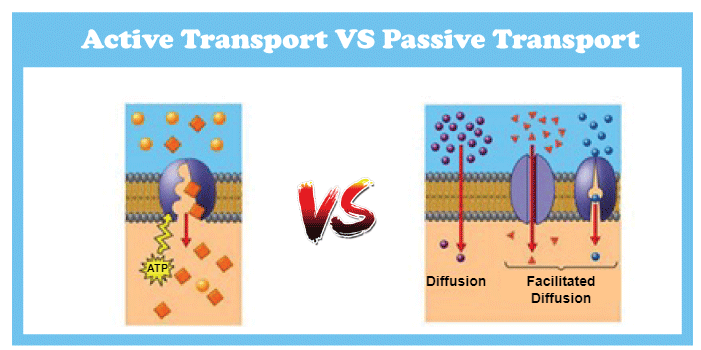Difference between Active and Passive TransportMolecules penetrate and move across membranes through two basic mechanisms called active and passive transport. These biological processes play a crucial role in maintaining the proper functioning of cells and ensuring that the necessary substances are transported across the cell membrane. Since both approaches involve the movement of molecules under certain circumstances, people often get confused between the two terms and use the terms interchangeably. Furthermore, both these processes have similar goals or objectives to achieve. However, there are significant differences between these two processes. Before differentiating between active and passive transport, let us understand each of these separately: 
What is Active Transport?Moving molecules or ions against their concentration gradient from a region of low concentration to one of high concentration, which is energetically unfavorable, is the complicated process known as active transport. Unlike passive transport, which is driven by concentration gradients and does not require energy input, active transport relies on the energy provided by the cell to move molecules across the membrane. This energy is usually in the form of ATP (Adenosine triphosphate), which is generated through cellular respiration. Active transport is carried out by specific proteins called pumps, which are embedded within the membrane and transport specific molecules or ions across the membrane. These pumps can move molecules in both directions, depending on the concentration gradient and the availability of energy. Pumps can be used to transport ions or molecules in uniport, symport, or antiport fashions. Uniport pumps typically transport a single molecule or ion across the membrane, while symport pumps move two or more molecules or ions in the same direction. Antiport pumps move two or more molecules or ions in opposite directions. Active transport is a vital process for the proper functioning of cells, and disruptions in this process can lead to various diseases and disorders. For example, defects in the sodium-potassium pump, which is responsible for maintaining the electrical potential of cells, can cause muscle weakness and cramps. Diabetes mellitus, a metabolic condition marked by elevated blood sugar levels, can also result from flaws in the glucose transporter pump. Understanding the mechanisms and regulation of active transport is crucial for developing therapies and treatments for various diseases and disorders. What is Passive Transport?Passive transport is a process of molecular transport across a membrane that does not require energy expenditure by the cell. The concentration gradient, which occurs when molecules migrate from one location of higher concentration to another of lower concentration, is what drives passive transport. This process occurs spontaneously and does not require any energy input from the cell. Passive transport is important for the maintenance of cellular homeostasis, where cells balance the concentration of molecules and ions within the cell with the surrounding environment. Simple diffusion, facilitated diffusion, and osmosis are the three basic ways by which passive transport can take place. Simple diffusion is the movement of small non-polar molecules, such as oxygen and carbon dioxide, through the cell membrane without the need for transport proteins. On the other hand, facilitated diffusion refers to the passage across the cell membrane of bigger or polar molecules like amino acids and glucose with the assistance of transport proteins. These transport proteins are specific to the type of molecule being transported and act as channels or carriers that facilitate the movement of molecules across the membrane. Osmosis is the passive movement of water molecules through a semi-permeable membrane from an area of low solute concentration to an area of high solute concentration. The solute concentration gradient causes a net movement of water across the membrane, which can cause cells to swell or shrink. Passive transport is an essential process for the proper functioning of cells, and any disruption can lead to various diseases and disorders. For example, cystic fibrosis is a genetic disorder that affects the transport of ions across the membrane, leading to thick mucus in the lungs and digestive system. Understanding the mechanisms and regulation of passive transport is crucial for developing therapies and treatments for various diseases and disorders. Difference between Active and Passive TransportAlthough the above information clears most of the things and concepts regarding active and passive transport processes, the following table may be more beneficial to quickly differentiate between active and passive transport:
ConclusionIn conclusion, active and passive transport are two different mechanisms by which cells move substances across their membrane. Active transport requires energy input, moves substances against the concentration gradient, and utilizes carrier proteins to transport molecules such as ions and amino acids. On the other hand, passive transport does not require energy input and moves substances down the concentration gradient by simple diffusion, osmosis, or facilitated diffusion. Understanding the difference between active and passive transport is essential to comprehend the various physiological and biological processes that occur in living organisms.
Next TopicDifference between
|
 For Videos Join Our Youtube Channel: Join Now
For Videos Join Our Youtube Channel: Join Now
Feedback
- Send your Feedback to [email protected]
Help Others, Please Share










